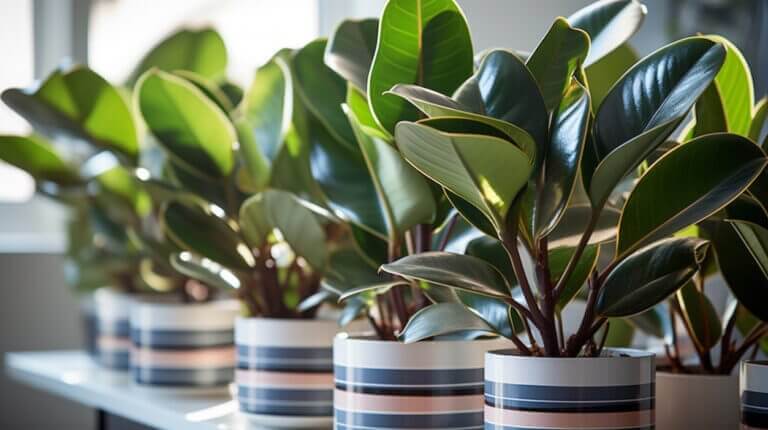As an avid gardener, I understand the importance of proper care for our beloved plants. One particular plant that requires attention and care is the African violet. To ensure their continued bloom and vibrant growth, it is essential to know when and how to repot African violets.
African violets should be repotted when the foliage crown reaches a few inches above the rim of the pot. Signs that it’s time to repot include yellowing and dropping lower leaves, a pot that is too small, and a plant that has become root-bound. When repotting, it’s important to use fresh soil and a well-draining potting mix to avoid issues like root rot. Repotting promotes new growth and encourages continued blooming.
Key Takeaways:
- Repot African violets when the foliage crown exceeds the pot rim.
- Signs you need to repot include yellowing and dropping leaves, a small pot, and root-bound growth.
- Use fresh soil and a well-draining potting mix to prevent root rot.
- Repotting promotes new growth and ensures continued blooming.
- Careful repotting is crucial for African violet plant care.
How Often Should You Repot African Violets?
African violets should be repotted at least twice a year to ensure their continued health and blooming. Regular repotting allows you to replenish nutrients, balance the soil chemistry, and accommodate new growth. However, it’s important to note that the frequency of repotting can vary based on the individual needs of your African violets.
Signs that it’s time to repot your African violets include a plant that has outgrown its pot, roots escaping through the drainage hole, and wilting leaves. These indicators suggest that the plant may be root-bound or lacking sufficient space and nutrients to thrive. By repotting regularly, you can encourage healthy growth and consistent blooming.
Keeping your African violets in optimal conditions also contributes to successful repotting. It’s important to choose a fresh potting mix specifically formulated for African violets, as it provides the necessary nutrients and good drainage. Additionally, ensuring that the soil is moist but not overly wet and providing proper drainage will help prevent issues like root rot.
| Signs that it’s time to repot: | How often to repot: |
|---|---|
| A plant that has outgrown its pot | At least twice a year |
| Roots escaping through the drainage hole | Varies based on individual needs |
| Wilting leaves |
By following these guidelines and being attuned to the signs that it’s time to repot, you can keep your African violets healthy and thriving. Regular repotting, using the right potting mix, and providing proper care will help ensure vibrant foliage and beautiful blooms.
How to Repot African Violets Step by Step
When it comes to repotting African violets, following a step-by-step process ensures the health and vitality of your plants. Here’s a guide on how to repot African violets effectively:
Step 1: Remove the Plant
To begin, gently tap the sides of the pot to loosen the plant. If necessary, use a knife to slide around the edges and carefully remove the plant from its current pot.
Step 2: Divide the Plant
Next, examine the plant’s root system. If the plant has become root-bound, you can divide it into two or three smaller plants. Ensure that each division has enough roots to thrive independently.
Step 3: Tease or Wash Away the Loose Soil
After dividing the plant, gently tease or wash away the loose soil from the roots. This step helps stimulate new root growth and removes any compacted or exhausted soil.
Step 4: Add Fresh Soil and More Soil if Needed
Place the divided plants in fresh soil, ensuring that the root system is covered without being buried deeper than before. If needed, add more soil to provide adequate support for the plants.
Step 5: Water the Plant and Remove Dead or Dying Leaves
After repotting, water the plant thoroughly to help settle the soil around the roots. Additionally, remove any dead or dying leaves to encourage new growth and maintain the plant’s overall appearance.
Following these steps will help ensure a successful repotting process for your African violets, promoting healthy growth and continuous blooming.
Table: Recommended Supplies for Repotting African Violets
| Supplies | Description |
|---|---|
| Potting Mix | A well-draining potting mix specifically formulated for African violets, containing ingredients like sphagnum moss and perlite. |
| Pots | Properly sized pots that allow enough room for the plant’s root system and provide adequate drainage. |
| Watering Can | A watering can with a narrow spout for precise watering, allowing you to avoid drenching the leaves and crown. |
| Scissors or Pruners | Sharp, clean scissors or pruners for cutting off dead or dying leaves and trimming roots if necessary. |
| Plant Labels | Labels to keep track of the plant’s name, date of repotting, and any other relevant information. |
| Spray Bottle | A spray bottle for misting the leaves, providing the necessary humidity for African violets. |
Best Practices for Repotting African Violets
When it comes to repotting African violets, following best practices is crucial to ensure the health and longevity of your plants. Here are some tips to help you repot your African violet plants successfully:
Use a Quality African Violet Potting Mix
One of the most important factors in repotting African violets is using the right potting mix. Look for a potting mix specifically formulated for African violets, which contains components like sphagnum moss and perlite for proper aeration and moisture retention. This will provide the ideal growing conditions for your plants and promote healthy root development.
Repot with Fresh Soil
When repotting your African violets, it’s essential to use fresh soil to replenish nutrients and ensure optimal growth. Remove the old soil and gently loosen the roots before placing the plant in the new pot. Add a small amount of fresh potting mix around the root system, making sure not to bury the plant deeper than it was before. This will help prevent issues like root rot and provide a fresh start for your plants.
Maintain Proper Moisture and Drainage
Keeping the soil moist but not wet is important for African violets. Water your newly repotted plants thoroughly but avoid overwatering, as excessive moisture can lead to root rot. Ensure that the pot you choose has proper drainage holes to allow excess water to escape. This will help prevent waterlogged soil and maintain a healthy environment for your African violets.
By following these best practices for repotting African violets, you can keep your plants happy and thriving. Remember to repot with fresh soil, use a quality potting mix, and provide proper moisture and drainage. With proper care, your African violets will continue to delight you with their beautiful blooms.
| Benefits of Best Practices for Repotting African Violets |
|---|
| Promotes healthy root development |
| Prevents issues like root rot |
| Ensures optimal growth and blooming |
| Helps maintain proper moisture levels |
| Provides a fresh start for your plants |
Tips for Repotting Overgrown African Violets
Repotting is an essential part of caring for African violets, especially when they become overgrown. Here are some tips to help you successfully repot your overgrown African violets.
Repotting with Fresh Soil
When repotting overgrown African violets, it’s crucial to use fresh soil. This ensures that the plants have access to the nutrients they need for healthy growth and blooming. Choose a high-quality potting mix specifically designed for African violets that provides good drainage. Fresh soil also helps prevent issues like root rot and encourages new growth.
Repotting African Violets with Long Necks
If your African violet has developed a long neck, repotting can help rejuvenate the plant. When repotting African violets with long necks, choose a slightly deeper pot to help cover the bare stem. This promotes new growth and encourages the plant to become more compact and bushy. Make sure to handle the plant with care during the repotting process to avoid further damage.
Repotting Trailing African Violets
Trailing African violets, also known as trailer violets, have a trailing growth habit and require specific care during repotting. The process for repotting trailing African violets is similar to repotting regular varieties. However, when placing the plant in the new pot, ensure that the trailing stems are positioned properly, so they cascade over the edges of the pot. This showcases their natural beauty and allows the plant to grow as it should.
Remember, repotting overgrown African violets may require a bit of patience and gentle handling. But with the right techniques and care, you can help your plants thrive and continue to bloom beautifully.
Common Mistakes to Avoid When Repotting African Violets
When repotting African violets, it’s important to be aware of common mistakes that can hinder the growth and health of these beautiful plants. While African violets are generally easy to care for, it’s crucial to avoid certain pitfalls when it comes to repotting.
One common mistake is repotting too often or unnecessarily. African violets tend to grow slowly, and they may not need frequent repotting. Repotting too often can disrupt their root system and cause stress to the plant.
Another mistake is repotting without proper knowledge or understanding of African violets’ specific needs. These plants require a well-draining potting mix, the right amount of moisture, and a suitable pot size. Ignoring these factors can lead to issues such as root rot or stunted growth.
To ensure successful repotting, it’s essential to repot your African violet only when necessary, keeping in mind that they tend to thrive and bloom without constant intervention. When repotting, choose the right potting mix, provide proper drainage, and maintain the right moisture level. By avoiding these common mistakes, you can help your African violets thrive and continue to beautify your space.
FAQ
When should African violets be repotted?
African violets should be repotted when the foliage crown reaches a few inches above the rim of the pot.
What are the signs that it’s time to repot African violets?
Signs that it’s time to repot include yellowing and dropping lower leaves, a pot that is too small, and a plant that has become root-bound.
How often should African violets be repotted?
African violets should be repotted at least twice a year to replenish nutrients, balance soil chemistry, and accommodate new growth.
How do you repot African violets step by step?
Start by gently tapping the sides of the pot to loosen the plant. If necessary, slide a knife around the edges. Remove the plant from the pot and gently tease or wash away the loose soil from the roots. Divide the plant into two or three smaller plants, ensuring each has enough roots. Place the plants in fresh soil, covering the root system without burying it deeper than before. Water the plant well and remove any dead or dying leaves to encourage new growth.
What are the best practices for repotting African violets?
The best ways to repot African violets include using a fresh potting mix specially formulated for African violets that contains sphagnum moss and perlite for aeration. Add a small amount of the mix to the pot, place the plant in, and cover the root system without burying it deeper. Repotting with fresh soil and using the right potting mix helps ensure the health of your African violet plants.
How do you repot overgrown African violets?
The process for repotting overgrown African violets is similar to regular repotting. Use fresh soil and repot with care, ensuring that the plant is placed in a slightly larger pot. For African violets with long necks, repotting in a deeper pot can help cover the bare stem and promote new growth. Repotting trailing African violets follows the same steps as repotting regular varieties.
What are common mistakes to avoid when repotting African violets?
Common mistakes to avoid when repotting African violets include repotting too often or unnecessarily, repotting without proper knowledge or understanding of the specific needs of African violets, using the wrong potting mix, and overwatering.






